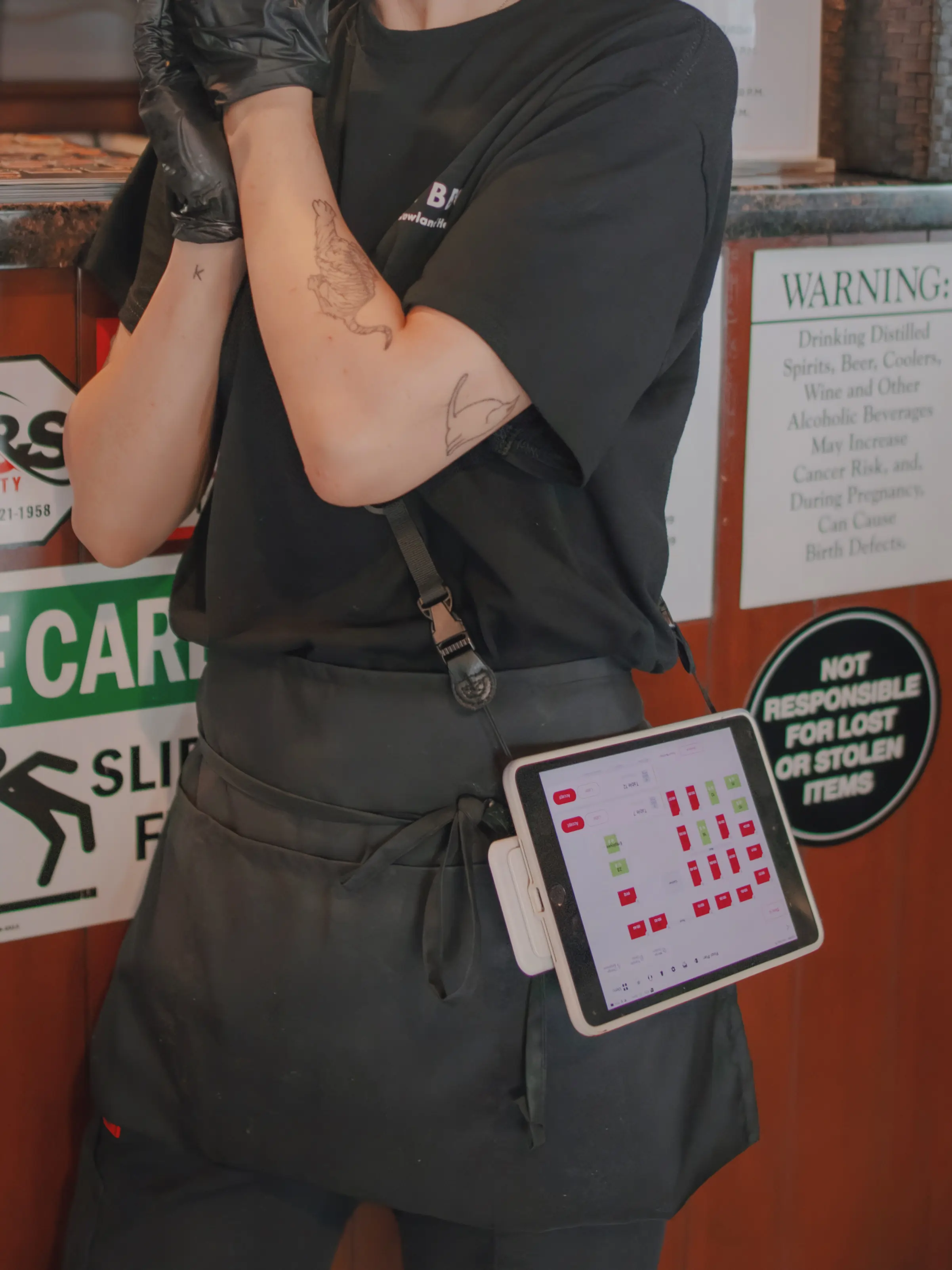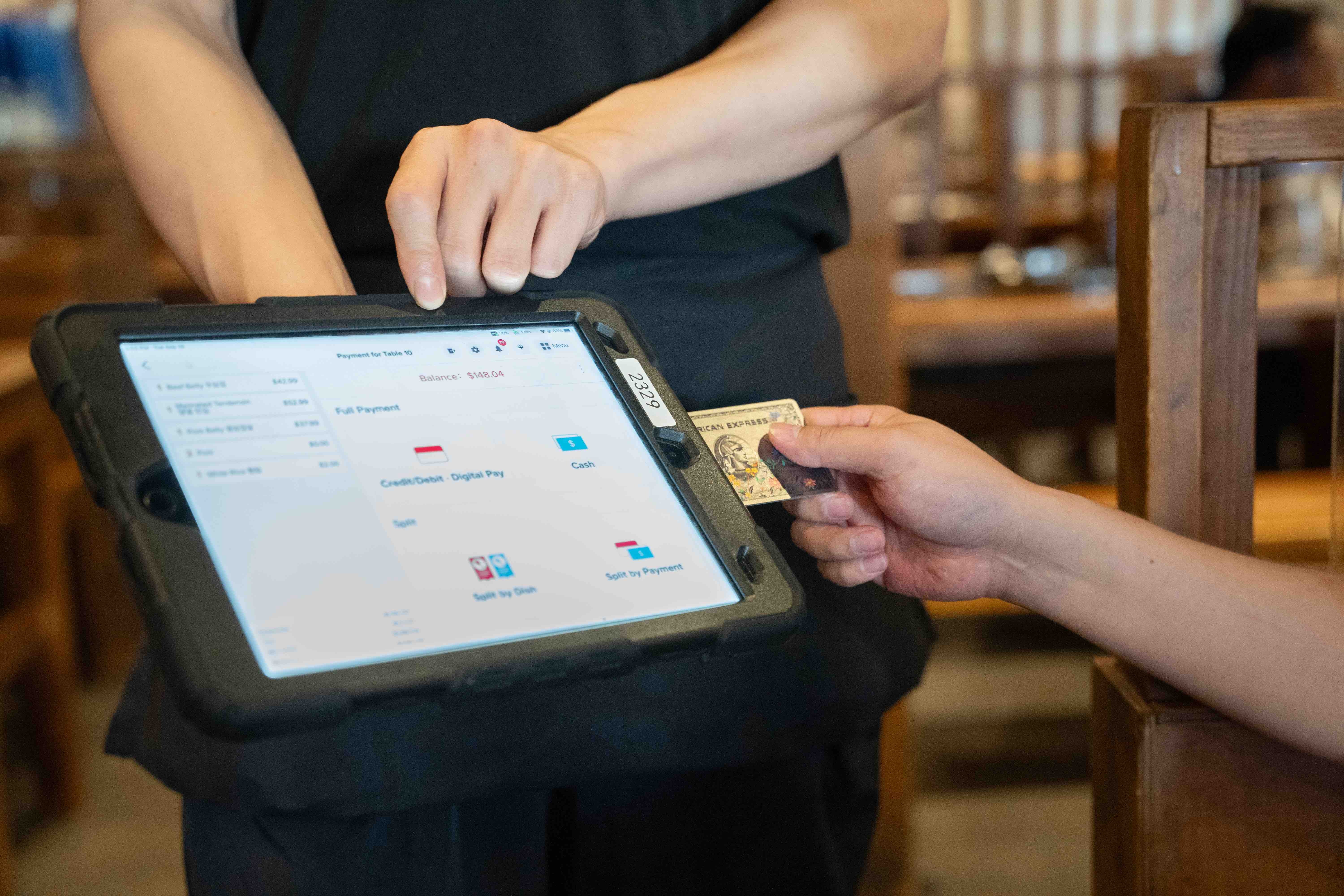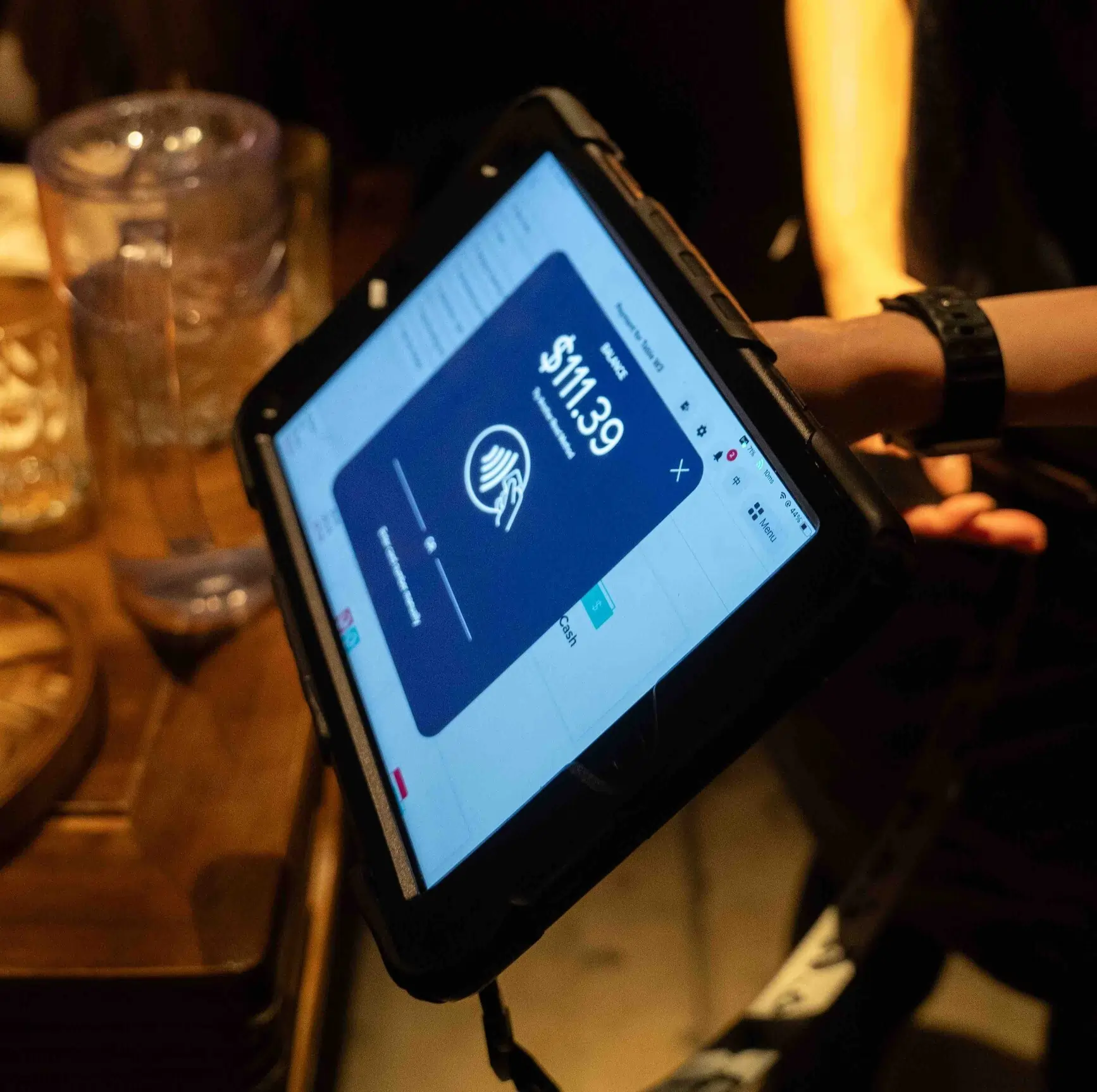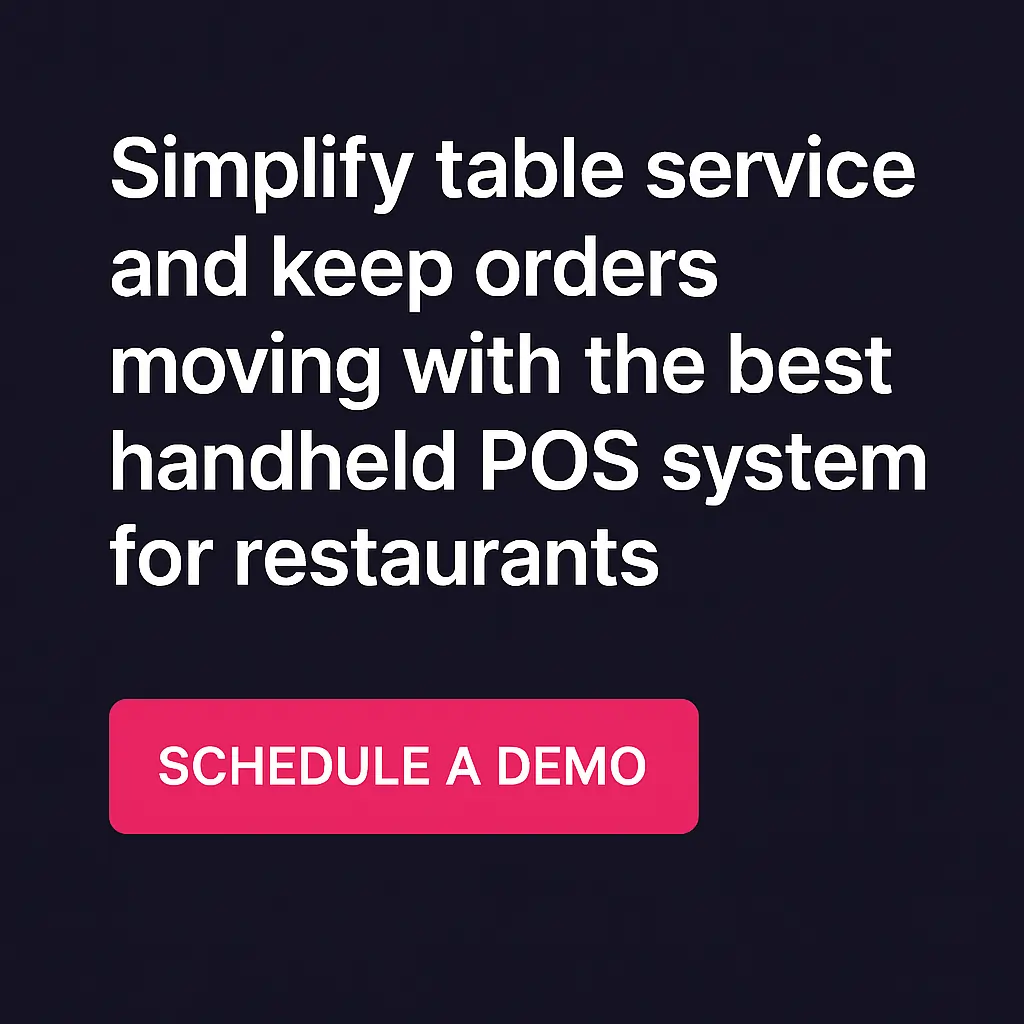
Struggling with slow service and frequent order mistakes? A handheld POS system for restaurants might be just what you need. These compact, portable systems have transformed the dining industry by boosting efficiency and enhancing customer service. Why are they essential in today’s restaurants? Because they streamline operations with speed and accuracy, ensuring that every order is delivered quickly and correctly.
In this guide, we’ll explore the significant benefits of handheld restaurant POS systems, including how they address common challenges such as miscommunication and hard-to-read handwritten orders.
We’ll also look at the various types of portable POS systems available and how they can be seamlessly integrated into your existing operations. If you’re ready to improve your restaurant’s efficiency and make every customer experience outstanding, continue reading to learn all about handheld POS systems.

Handheld POS systems are compact, wireless devices that allow restaurant staff to manage orders and process payments directly at the table. Unlike traditional POS systems, which are often stationary, these portable devices offer the freedom to interact more fluidly with customers, providing a streamlined and personalized service experience. They typically come equipped with all-in-one functionalities of a full-scale POS, including order management, payment processing, and receipt printing, all within a device that fits in the palm of your hand.
In today’s connected and tech-driven era, the demand for swift and convenient service in the dining industry has never been higher. To meet these modern expectations, handheld POS systems have become essential tools for restaurants striving to enhance service efficiency and customer satisfaction. Here’s why they are crucial:
The utility of these systems extends beyond just order taking and data collection. Let’s explore how these powerful tools function in a typical restaurant setting.

The basic process of a Handheld POS system is straightforward and efficient. When a customer places an order, the server or waiter uses the handheld device to input the order details, which are instantly transmitted to the central POS system.
This seamless communication ensures the kitchen staff receives orders promptly, minimizing delays and errors. Once the meal is ready, the server can also use the handheld device to notify the customer’s table, ensuring the food arrives hot and fresh.
However, the functionality of handheld POS systems doesn’t stop with order placement. These devices are equipped with integrated scanners and receipt printers, allowing for quick and convenient payment processing right at the customer’s table. This includes modern payment methods like credit cards and NFC payments like Apple Pay, Google Pay, and other mobile payment platforms.
This not only enhances the overall dining experience but also helps increase table turnover rates and boost tips through easy tip selection functions.
For seamless operation, Handheld POS systems often require integration with your central POS system and other restaurant management software. This ensures that your inventory, menu items, and customer data are synchronized across all devices, minimizing errors and saving valuable time.

Handheld POS devices come in various forms, each catering to specific needs and preferences. The two primary types are:
Both types of handheld POS systems offer seamless integration with a restaurant’s POS software. This ensures that all orders and payments are synchronized with the central system, reducing the chances of errors and discrepancies.
The advantages of adopting wireless handheld POS systems in your restaurant are abundant and can significantly impact your business. Here are some key benefits:
These benefits demonstrate why handheld POS systems are crucial for improving overall restaurant operations. However, the effectiveness of these systems largely depends on choosing the right one that fits your specific needs.

Selecting the right handheld POS system for your restaurant is a decision that should not be taken lightly. Here are some key factors to consider:
A handheld POS system should feature an intuitive interface that is easy for your staff to navigate. The learning curve should be minimal, ensuring that your team can become proficient quickly and reduce the time spent on training.
Ensure the system includes features that cater specifically to your restaurant’s demands. These might include menu customization, efficient table management, and comprehensive reporting tools. Such features help streamline operations and enhance service delivery.
Protecting your customers' payment information is crucial. Opt for a POS system with advanced security features to ensure that customer data is handled securely and to safeguard your business against potential breaches.
Consider both the initial investment and the ongoing operational costs associated with the POS system. Assess the overall value it brings to your business, including how it could potentially reduce other costs or increase revenue through more efficient service.
Ensure the POS provider offers responsive customer support and regularly updates the software to enhance functionality and security. This ensures that the system remains reliable and evolves with technological advancements.
The handheld device should be compact and lightweight, making it easy to carry and use anywhere in the service environment. This helps facilitate quick transactions directly at the table or point of service.
Look for systems with integrated scanners and receipt printers to streamline the payment process. A touch screen that can capture digital signatures is also essential for securing payments and reducing transaction disputes.
Ensure your POS system supports both WiFi connectivity and offline mode capabilities. A reliable WiFi connection is crucial for accessing cloud-based services and performing real-time updates. Additionally, offline POS functionality allows for continuous operation, even during internet outages, ensuring that your service remains uninterrupted and efficient at all times.
Ensure your handheld POS system integrates seamlessly with existing POS software and loyalty programs. This integration is essential for maintaining data consistency, enhancing operational efficiency, and improving customer retention. The capability to blend smoothly with your current systems guarantees that all aspects of your restaurant’s operations are streamlined and effective.
Considering a restaurant's busy and sometimes chaotic environment, it’s important that the handheld POS system is sturdy and can withstand daily use. A durable system ensures longevity and reliability, avoiding frequent replacements or repairs.

When selecting a handheld POS system, you want a solution that not only meets the immediate needs of your restaurant but also enhances your service and operational efficiency. The Chowbus POS Handheld is designed with your restaurant's future in mind. Here’s what makes it stand out:
Chowbus POS Handheld integrates seamlessly with your existing operations, enhancing service efficiency and customer satisfaction. Its robust design, coupled with cutting-edge features, makes it the ideal choice for improving your restaurant’s performance and profitability.

Looking ahead, the future of handheld POS systems promises exciting advancements. Emerging restaurant technologies such as artificial intelligence and machine learning are expected to optimize order accuracy and customer preferences analysis further.
Innovations like contactless payment methods and biometric authentication are set to enhance the security and convenience of transactions. Keeping an eye on these trends can help you stay ahead of the curve and continue to provide top-notch service to your patrons.
In the competitive world of modern restaurants, staying ahead of the curve is essential. Portable POS systems have proven to be transformative, enhancing operational efficiency and customer satisfaction. As a restaurant owner, investing in the right handheld POS system can transform your business, leading to increased profitability and loyal customers.
Don’t miss the opportunity to revolutionize your restaurant’s operations. Book a free demo of Chowbus POS Handheld today and experience the seamless integration of innovation and convenience. Elevate your restaurant’s performance, one table at a time.

In this section, we will address frequently asked questions about handheld POS systems for restaurants, providing you with clear insights and valuable information.
The best POS system for a fast food restaurant is Chowbus POS. It offers user-friendly, self-ordering technology, allowing customers to browse and order menu items easily. You can update digital menus with a few clicks, eliminating print costs. It supports multiple languages and helps cut wait times by sending customer orders directly to the kitchen. Guests can order via QR code, online, or kiosks and receive automated SMS notifications when orders are ready. This system improves customer experiences, leading to more returning guests, and can save up to $8,000 per month in labor costs. Plus, loyalty, CRM, and gift card programs help turn one-time customers into regulars.
The four types of POS systems are:
Most restaurants use a restaurant POS (Point of Sale) system. This system is a comprehensive software and hardware solution designed to streamline various aspects of restaurant operations, including order management, payment processing, inventory tracking, and customer management.
POS stands for Point of Sale. It refers to the physical location where a transaction occurs, typically involving exchanging goods or services for payment. On the other hand, a POS system stands for a Point of Sale system. It is a comprehensive hardware and software solution businesses use to process transactions, manage inventory, track sales, and handle various other business operations.
While POS signifies the specific point where the transaction occurs, a POS system encompasses the entire setup, including the cash register, receipt printer, barcode scanner, and the associated software used to streamline and optimize the sales process.
POS systems outperform cash registers due to their speed, automated inventory management, detailed sales analytics, CRM capabilities, seamless integration, and advanced security features. These advantages enhance efficiency, accuracy, customer satisfaction, and overall business operations, making POS systems the preferred choice for modern businesses.
Implementing a POS system in your restaurant is crucial for streamlining operations, improving efficiency, and enhancing customer satisfaction. A POS system helps you manage orders, track inventory, process payments, and analyze real-time sales data.
By investing in a POS system, you can optimize your restaurant’s workflow, reduce errors, and provide better service to your customers. Don’t hesitate to invest in a POS system to enhance your restaurant’s performance and profitability.

Recommended Articles: